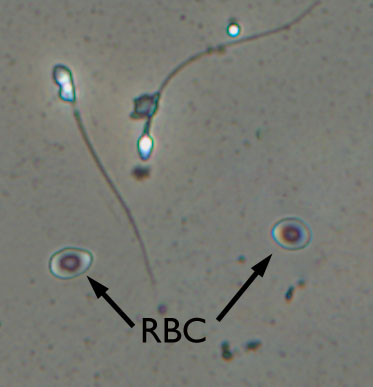Non-sperm Cells in Semen

In addition to morphologically mature sperm cells, human semen commonly contains other cells that should be specified in the semen analysis. Whereas some are readily identifiable as epithelial cells by their unique polygonal shape, other cells are round and include germinal cells (aka spermatogenic or immature sperm cells) and leukocytes.
Initial round cell identification occurs during microscopic examination when the sperm count is performed. The number of non-mature sperm cells can be described either as the number per field (usually high power 400X) or by concentration, a more robust measure. The number of round cells should be counted and the concentration calculated.

When the concentration exceeds 1 million per ml, the type (s) of round cells present should be determined using a stained semen smear or a biochemical reaction. In a stained prep, most observers trained in hematology will readily appreciate the difference between a granulocyte and germinal cells, but technologists unaccustomed to blood film analysis often have difficulty distinguishing between the two. However, the unique appearance of semen with sperm and other non-leukocytes can be confusing for expert hematologists too. Our Semen Morphology Smears (AQC105) can be used to learn or validate the ability to discern leukocytes from germinal cells.
Spermatocytes & Spermatids

The presence of excessive germinal cells indicates disruption of spermatogenesis that may be related to viral illness, toxicant exposure, chemotherapy or genetic problems.
Polymorphonuclear leukocytes, Monocytes & Spermiophage

When semen granulocyte and monocyte concentration exceeds 1-2 million per ml, inflammation or infection should be suspected.
Leukocytospermia
Leukocytospermia is associated with symptomatic infections such as chlamydia, mumps orchitis, syphilis, and tuberculosis that can cause irreversible sterility or asymptomatic gonorrhea. Inflammation can be caused by bicycling-induced epididymitis and other non-infectious problems. Leukocytospermia has been associated with severe male factor infertility. Through the release of hydrogen, other reactive oxygen species, and pro-inflammatory bioactive cytokines including GRO-alpha, leukocytes can cause significant lipid peroxidation of sperm membranes. Damage may be manifested as asthenozoospermia (decreased sperm motility), decreased sperm viability, reduced sperm capacitation, acrosome reaction.
Erythrocytes
Low concentrations of erythrocytes (RBCs) in semen can be an artifact caused by skin irritation during collection. RBCs in high concentrations in semen can indicate infection or injury.



